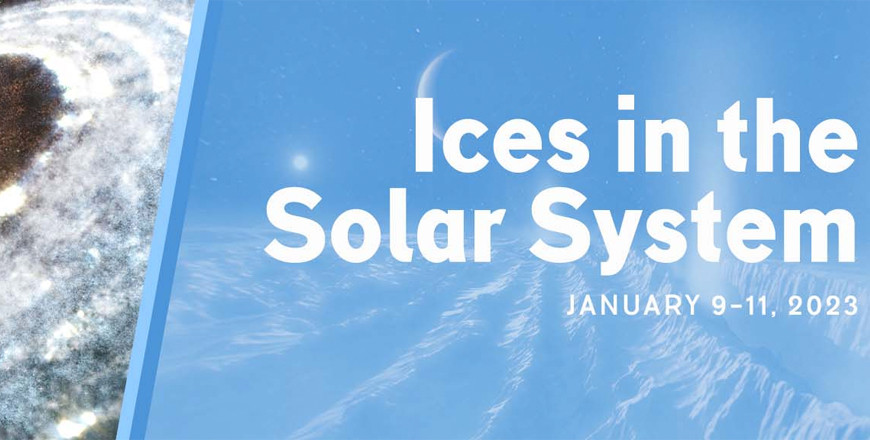
SPACE/Space enables us to look out, about and up, and to recognize that a Ptolomaic weltanschauung not only constrains and controls us but binds us to worlds of thought already explored and somewhat spent.
The four presentations that comprise this Friday afternoon speakers’ series sweep through the solar system and present the latest/greatest thinking on worlds still largely unknown. The presentations elaborate:
1) the possible presence of a sub-surface Europan ocean;
2) Saturnian ring-composition;
3) the cold-trapping of frozen water on the Moon; and,
4) the possibility of paleo-lakes on Mars.
To these worlds we will go, today; where we end up, nobody knows!
Note: Dawson students who are interested in participating in activities, research and co-curricular, related to a Dawson College planetary science group are invited to join the SPACE certificate to find out more.
Ishan Mishra
Hello! I am a postdoctoral research scholar in the Planetary Geosciences section of the NASA Jet Propulsion Laboratory (JPL) in California. My research interests involve analyzing reflected light data from planetary surfaces using physical models and statists. The goal is to infer properties such as composition, surface texture, etc. I received my PhD at Cornell University's Department of Astronomy, where I worked on developing tools to infer the chemical composition of planetary surfaces. Ocean worlds in the outer solar system are especially fascinating to me and I am an affiliate of the Europa Clipper science team. As such, I get to witness the behind-the-scenes development of NASA's most ambitious planetary science mission yet as part of my daily job, which is mind blowing!
Amanda Hendrix
Amanda Hendrix is a senior scientist at the Planetary Science Institute. Her research, which focuses on UV-visible spectroscopy of solar system surfaces, includes moon and asteroid composition, space weathering effects and radiation products. She has been a co-investigator on NASA’s Cassini, Galileo and Lunar Reconnaissance Orbiter missions, is a Principal Investigator on the Hubble Space Telescope observing programs and is the Principal Investigator of NASA’s Toolbox for Research and Exploration. Amanda also worked for NASA’s Jet Propulsion Laboratory studying asteroids and icy moons, and was the Deputy Project Scientist for the Cassini Mission at Saturn. She is co-chair of the National Academies Committee on Planetary Protection, chair of NASA's Outer Planets Assessment Group, and served as chair of the American Astronomical Society’s Division for Planetary Sciences. She holds a B.S. in Aeronautical Engineering from California Polytechnic State University and a Ph.D in Aerospace Engineering Sciences from the University of Colorado. In 2000, she was a NASA astronaut candidate finalist, and she is the namesake of asteroid 6813 Amandahendrix.
Pierre Williams
Jean-Pierre Williams is a planetary scientist at the University of California in Los Angeles (UCLA). He received his PhD in Geophysics and Space Physics from UCLA and was a research scientist at the California Institute of Technology for five years before accepting a position at UCLA. His work focuses on the geology and physics of the inner planets, and he has authored and co-authored over sixty peer-reviewed publications on Mars, Mercury, and the Earth’s Moon. He is currently the Deputy Principle Investigator of the Diviner Lunar Radiometer Experiment on the Lunar Reconnaissance Orbiter, a member of the ShadowCam instrument team on the Korean Pathfinder Lunar Orbiter (Danuri) mission, which will image the permanently shadowed regions near the poles of the Moon, and a Co-Investigator of the Lunar Vulkan Imaging and Spectroscopy Explorer (Lunar-VISE), a lander and rover that will explore the summit of a volcanic dome on the Moon.
Timothy Goudge
Tim Goudge is an Assistant Professor in the Department of Geological Sciences within the Jackson School of Geosciences at the University of Texas at Austin. Prior to UT, Dr. Goudge received a BSc in geological engineering from Queen’s University, and a MSc/PhD from Brown University.
Dr. Goudge’s research focuses on the use of remote sensing data to study the signature of surface processes recorded in the topography, mineralogy, and sedimentary rock record of Mars, Earth, and other planetary bodies. Much of his past work has focused on unraveling the record of ancient lake basins on Mars, which represent a major component of the ancient martian hydrosphere. Dr.
Goudge's work on paleolake basins has included identification of new systems, and work to constrain the temporal evolution of lake basins, showing that, over time, Mars' lake record become more dominated by water-limited, hydrologically-closed systems. Additionally, Dr. Goudge has focused on understanding how paleolake basins interacted with surrounding fluvial systems, both inlets that provided water to lakes, and outlets that drained water from within the basin. Dr. Goudge and his research group have also studied sedimentary deposits within lake basins, using them to decipher the record of formative water flow conditions responsible for transporting the sediment into these lake basins.
Comments
No comments posted yet.
You have to be registered and logged in in order to post comments!